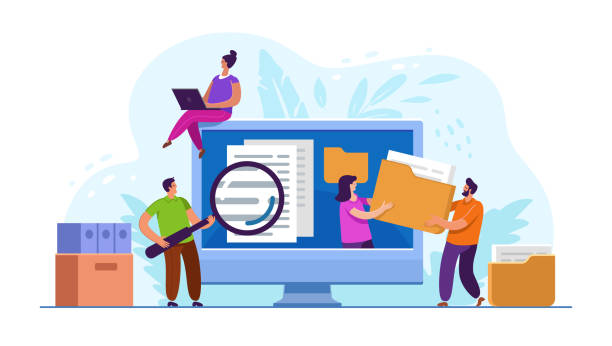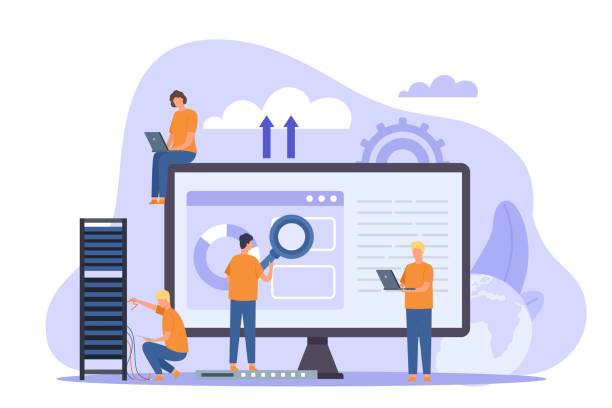Introduction to the Importance of Secure Website Design in Today’s Digital World

In today’s digital age, where new information is constantly produced and exchanged, secure website design is no longer an option but an undeniable necessity.
Imagine having a website that serves as the main base for your business or an information platform; without adhering to security principles, this website can become an easy target for cyberattacks.
The importance of this issue is not only related to protecting user information and sensitive business data but also directly impacts reputation and user trust.
An insecure website can lead to data loss, disclosure of personal information, phishing attacks, and even misuse of server resources.
A deep understanding of existing threats and the application of preventive solutions is the first step on the path to secure website design.
This section provides an overview of the topic and introduces you to various dimensions of this challenge and opportunity.
From identity theft to Distributed Denial of Service (DDoS) attacks, a wide range of risks can compromise your website.
The main goal is to build a website that is resilient to these threats and reassures users.
Does your current company website not reflect your brand’s credibility and strength as it should? Rasaweb solves this challenge for you with professional company website design.
✅ Increased credibility and visitor trust
✅ Targeted attraction of more customers
⚡ Click for free consultation!
Identifying Common Web Security Threats and Vulnerabilities

In the journey of secure website design, the second step is to accurately identify threats and vulnerabilities.
Cyberattacks are becoming increasingly complex, and understanding these methods can help us defend better.
Among the most common threats are SQL Injection attacks, where an attacker accesses sensitive information by injecting malicious code into the database.
Another is Cross-Site Scripting (XSS) attacks, which allow client-side script injection and can lead to cookie theft or website content alteration.
DDoS (Distributed Denial of Service) attacks also aim to render the service unavailable by sending a massive volume of traffic to the server.
Furthermore, vulnerabilities related to incorrect server configurations, the use of weak passwords, failure to update software and libraries, and improper validation of user inputs are other security gaps.
Understanding these specialized weaknesses is crucial for anyone seeking to implement secure website design.
This section provides an in-depth analysis of various attack types and how attackers exploit vulnerabilities to prepare you to counter them.
Principles of Secure Coding and Vulnerability Prevention

Secure coding is one of the main pillars in the secure website design process.
Developers must approach coding with a security mindset from the outset to prevent many vulnerabilities.
The most important principle is thorough validation of all user inputs; whether through forms, URL parameters, or cookies.
Lack of validation can pave the way for attacks such as SQL Injection or XSS.
Using standard and up-to-date security functions and frameworks, instead of developing security solutions from scratch, can significantly enhance code security.
Also, proper error handling and preventing the display of sensitive system information on error pages are other vital considerations.
This educational and guidance section outlines the best coding practices for preventing common vulnerabilities.
Below is a table of best practices for secure coding:
| Security Principle | Description | Practical Example |
|---|---|---|
| Input Validation | Reviewing and sanitizing all user input data to prevent code injection. | Using Prepared Statements for SQL queries. |
| Data Encryption | Protecting sensitive information during transmission and storage. | Using HTTPS (SSL/TLS) and encrypting passwords (hashing). |
| Error Handling | Displaying general error messages to the user and logging details for the administrator. | Avoiding the display of technical error details (such as file paths or database specifics) to end-users. |
| Continuous Updates | Ensuring the use of the latest versions of software and libraries. | Patching the operating system, frameworks, and CMS as soon as security updates are released. |
The Importance of HTTPS and SSL/TLS Protocols in Ensuring Security

Secure data transfer protocols such as SSL/TLS (which form the foundation of HTTPS) are the cornerstone of secure communications on the web and are an integral part of secure website design.
These protocols encrypt data sent and received between the user’s browser and the website server, preventing interception, manipulation, or eavesdropping by third parties.
When a website uses HTTPS, a green padlock or the word “Secure” appears in the browser’s address bar, assuring the user that their information is being transmitted securely.
Failure to use HTTPS not only leads to browser security warnings but also affects the website’s SEO ranking, as Google prefers HTTPS-enabled websites.
This is especially crucial for websites that process sensitive information such as bank card details or personal information.
Investing in a valid SSL/TLS certificate and implementing it correctly is a fundamental step towards building a secure website and gaining user trust.
This is an explanatory and specialized principle that every website should adhere to.
Did you know that 85% of customers check your company’s website before any interaction?
With Rasaweb, build a corporate website that reflects your credibility.
✅ Increase customer credibility and trust
✅ Attract quality leads
⚡ Get a free website design consultation!
Database Security and Defense Against SQL Injection

Database security is one of the most important aspects of secure website design, as it often stores vital website information including user data, transactions, and content.
One of the most common and dangerous attacks against databases is SQL Injection.
This attack occurs when an attacker executes unauthorized commands to the database by entering malicious SQL code into website input fields, which can lead to data access, modification, or deletion.
To counter this threat, using Prepared Statements (or parameterized queries) and ORM (Object-Relational Mapping) is one of the most effective solutions.
These methods ensure that user inputs are processed as data, not as part of the SQL command.
In addition, database users should be granted the least possible access, providing only the necessary permissions for required operations.
Encrypting sensitive information in the database, regularly updating the Database Management System (DBMS), and performing regular backups are also essential measures to enhance database security and ensure the security of online platforms.
This guidance and specialized section introduces you to the details of protecting the heart of your website’s data.
Authentication Standards and User Access Management

Within the framework of secure website design, user authentication and access management are of paramount importance.
These principles ensure that only authorized users have access to specific website resources.
Using strong passwords that are a combination of uppercase and lowercase letters, numbers, and symbols is the first step.
Additionally, implementing Two-Factor Authentication (2FA) significantly increases the security of user accounts, because even if a password is compromised, the attacker needs a second factor (e.g., a code sent to a mobile phone) to log in.
Session Management must also be carefully implemented to prevent session hijacking attacks; meaning sessions should have an expiration time and be properly destroyed after the user logs out.
The Role-Based Access Control (RBAC) system also allows website administrators to control user access on a granular basis according to their roles (e.g., administrator, editor, regular user).
This educational and guidance section helps you create a secure and effective access management system for your website, thereby contributing to comprehensive secure website design.
The Importance of Security Audits and Continuous Updates

Regular security audits and continuous updates are two vital elements in maintaining secure website design over time.
Security is not a static process, but a continuous effort, as cyber threats are constantly evolving and becoming more complex.
Conducting periodic security audits, including Penetration Testing and vulnerability scanning, helps identify weaknesses and security gaps before they are discovered by attackers.
This informative and analytical process gives you a real insight into your website’s security status.
It is also essential to ensure that all software, frameworks, plugins, and the server’s operating system are updated to the latest stable and secure versions.
Many successful cyberattacks occur due to the exploitation of known vulnerabilities in older software versions.
Establishing a regular patching and update schedule not only helps maintain website development with a security-first approach but also makes your website resilient against emerging threats.
Below table shows a checklist of important items in security auditing and updates:
| Item | Description | Recommended Frequency |
|---|---|---|
| Penetration Testing (Pentest) | Simulating attacks to discover vulnerabilities. | Annually or after major changes. |
| Vulnerability Scanning | Using automated tools to find security weaknesses. | Monthly or quarterly. |
| Software Updates | Patching the operating system, frameworks, CMS, and plugins. | As soon as security updates are released. |
| Log Review | Analyzing server and application logs to identify suspicious activities. | Daily or weekly. |
Incident Response and Disaster Recovery Planning

Even with the best secure website design approaches and adherence to all protocols, the possibility of cyberattacks is not zero.
Therefore, having an Incident Response Plan and a Disaster Recovery Plan is crucial.
These plans provide step-by-step guidance for responding to a security incident, limiting damage, eliminating the threat, and restoring normal website functionality.
This guidance and specialized section shows you how to prepare for worst-case scenarios.
The first step in an incident response plan is to identify and isolate the compromised system to prevent the spread of contamination.
Then, root cause analysis of the incident, attacker removal, and vulnerability remediation are performed.
In the recovery phase, using healthy and reliable backups to restore critical information is vital.
These plans also include training employees to detect and report security incidents.
Business continuity and building a secure website against unexpected events depend on carefulness and preparedness at this stage.
Are you tired of your company’s website not meeting your expectations? With Rasaweb, design a professional website that truly represents your business.
✅ Increase attraction of new customers and sales leads
✅ Boost your brand’s credibility and trust with your audience
⚡ Get a free website design consultation!
The Future of Secure Website Design and the Role of Emerging Technologies

With the rapid advancement of technology, the future of secure website design is also evolving.
Emerging technologies such as Artificial Intelligence (AI) and Machine Learning (ML) play an increasing role in detecting and preventing security threats.
AI-powered systems can identify anomalous traffic patterns and stop attacks before they damage the website.
Also, Blockchain technology has the potential to create more secure platforms for authentication and data storage.
The concept of “Zero Trust” cybersecurity, which emphasizes not trusting any user or device (even within the network), is also expanding and is proposed as an advanced approach to securing online platforms.
This informative, engaging, and thought-provoking section explores the challenges and opportunities that new technologies create in the field of website security and provides a vision of what awaits us in the future.
Can humans always stay one step ahead of attacking AI? This is a question the future will answer.
Fostering a Culture of Security and Collective Responsibility

Secure website design is not just about coding and technology; it is heavily dependent on fostering a security culture and collective responsibility within the organization.
Even the most advanced security systems are vulnerable to human error.
Educating employees about common threats such as phishing, the importance of using strong and regular password updates, and recognizing suspicious patterns can act as the first line of defense.
This analytical and guidance section emphasizes that security is a team effort and not solely the responsibility of the IT team.
Managers, developers, marketers, and even end-users all play a significant role in maintaining security.
Creating a work environment where security is considered a core value and all members feel responsible for it is of great importance.
Holding training workshops, sharing security news, and encouraging the reporting of any suspicious activity can help strengthen this culture and ensure the long-term sustainability of secure website design.
Frequently Asked Questions
| Question | Answer |
|---|---|
| What is secure website design? | Secure website design is the process of building websites with security principles in mind to make them resilient against cyberattacks and protect user and business information. |
| Why is secure website design of high importance? | To prevent unauthorized data access, sensitive information leaks, malware attacks, loss of user trust, damage to business reputation, and legal consequences resulting from data breaches. |
| What are the most common website vulnerabilities? | SQL Injection, Cross-Site Scripting (XSS), Cross-Site Request Forgery (CSRF), broken authentication and session management, and sensitive data exposure. |
| How can SQL Injection attacks be prevented? | Using Prepared Statements with parameterized queries, Input Validation, and limiting database access. |
| What are the methods to counter XSS (Cross-Site Scripting) attacks? | User Input Validation, Output Encoding before displaying in HTML, and using Content Security Policy (CSP). |
| What is the role of HTTPS in website security? | HTTPS encrypts communication between the user’s browser and the website server using an SSL/TLS certificate, preventing eavesdropping, manipulation, or forgery of data. |
| What are the best practices for user password management? | Enforcing strong passwords (a combination of letters, numbers, and symbols), hashing passwords instead of direct storage (with strong algorithms like bcrypt), and enabling Two-Factor Authentication (2FA). |
| What is the importance of User Input Validation? | Input validation prevents malicious or unexpected data from entering the system, which can lead to vulnerabilities such as SQL Injection or XSS. |
| What is the impact of regular security reviews and audits on site security? | These reviews help identify vulnerabilities and security weaknesses early, allowing them to be fixed before they can be exploited. |
| What is the application of Web Application Firewall (WAF) in secure website design? | WAF acts as a protective layer between the user and the website, analyzing incoming traffic, identifying, and blocking common web attacks such as SQL Injection and XSS. |
And other services of Rasaweb Advertising Agency in the field of advertising
Smart Marketplace: A combination of creativity and technology to increase click-through rates through intelligent data analysis.
Smart Digital Branding: A combination of creativity and technology to increase click-through rates by customizing user experience.
Smart Social Media: Revolutionize customer behavior analysis with the help of intelligent data analysis.
Smart Google Ads: Transform campaign management with the help of intelligent data analysis.
Smart Direct Marketing: Designed for businesses seeking digital branding through SEO-driven content strategy.
And over hundreds of other services in internet advertising, advertising consultation, and organizational solutions
Internet Advertising | Advertising Strategy | Advertorials
Resources
Website Security Checklist
Website Security Tips
Secure Web Design
Website Security Best Practices
? Are you ready to transform your business in the digital world? Rasaweb Afarin Digital Marketing Agency, with a specialized team and an innovative approach, offers comprehensive and effective solutions for your powerful online presence.
From website design with a modern user interface and professional SEO to intelligent social media management and targeted advertising campaigns, we provide everything you need to shine online. With Rasaweb Afarin, take a big step towards lasting success.
📍 Tehran, Mirdamad Street, next to Bank Markazi, Southern Kazeroun Alley, Ramin Alley, No. 6

